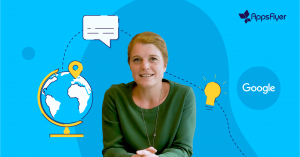
Making user acquisition work in the age of automation
Welcome to another edition of MAMA Boards, an AppsFlyer video project featuring leading mobile marketing experts on camera.
For today’s mini whiteboard master class, we have Yury Bolotkin, Growth Specialist at Popcore, a leading creator of Hyper Casual games.
Yury dives into how Popcore automates creatives and campaigns, specifically their management and bidding. He also reveals what kinds of tools they use to make the process more efficient. There’s plenty to gain from automating some of your processes so you can focus on things that matter and require humans!
Real experts, real growth. That’s our motto.
Enjoy!
Transcription
Hello, welcome to another edition of MAMA Boards by AppsFlyer.
I’m Yury, growth specialist at Popcore. Popcore is a Berlin-based game developer creating beautiful, oddly-satisfying, hyper casual games. And today we’re going to talk about marketing automation.
Before I start, I would like to mention that there are a number of tools that you need to have in order to achieve that. I will get down to the tools a bit later.
And now, we come to the first point, which is, “What can you automate?”
Here at Popcore, we decided we can focus on two things, which are creatives and campaigns. And campaigns are also broken down by management and bidding in the campaigns.
Okay, let’s go to creatives automation.
As you all know, iterating on creatives is a long process. It’s basically an infinite loop. So when our creative team comes up with an idea, and then produces video content, lots of video content, we want to run a test. And to do that, we ask our script to upload everything to our ad network that we select. And we run the test, and overnight, we get the results, which we can communicate back to our creative team, or discuss internally to find out who are the winners or who are the losers in our test. And therefore, when we got the results, we want the best of the best results to be implemented into our live campaigns.
That’s how we’ll close the loop, and that’s how this circles starts all over again.
Why do we do this? Easy, just in one week, our creative team can produce hundreds of video creatives. And we need to test all of them and select the best ones.
And also, to upload all of this, even winning creatives, to our live campaigns, we will spend hours. And with the help of a script, we can do it in just ten minutes.
Now let’s talk about the second part, which is campaign automation. In this part, I’m going to talk about the script, which also can be used in the first part, for example, refresh your best-performing creatives in your live campaigns.
So campaign automation consists of two things: campaign management and campaign bidding. In campaign management, we mean at Popcore the set of rules that we run using our in-house developed tools or some third-party tools that are pretty simple, actually.
For example, if your day one retention hits a certain threshold and your count of installs is more than a certain amount, so you make sure you have enough figures to make a decision, then you do your decision. You change your bids, you change your caps. As a vivid example, Google Ads, a network that requires simultaneously hundred and hundreds of campaigns running, when for example we scale our new title.
To keep all of these campaigns aligned, and doing what we want from them, we run these simple rules on top of our campaigns to keep them intact.
For example, we limit their bids, we increase their bids, we limit their daily caps, or we increase daily caps. Campaign bidding using scripts is done using a small piece of code written in Python with the help of our data science team. So, as an input, we use our export from a network of choice, an export of campaign structure. And a second input is an export from our statistics, from BI or any reporting tool that we use. Combining those two data, we have a third file as an output that can be used to upload to the same network, to change your campaign structure, your bids, your creatives.
As an example, we use as an input old campaign structure using old creatives, and then we have a list of new creatives that we tested and that we know that will work even better than the previous ones.
Combining that with a Python script, we can produce a wholly new campaign structure using new creatives and upload them in just about several minutes to our network of choice. That saves us a lot and a lot of time every week. And also, we can manage hundreds and hundreds of line items that are currently live in all of our campaigns.
So now, the tools.
Which tools we had to have in order to do this automation at Popcore?
So first, we had our BI system or reporting. Of course, it’s basic.
Then, our media partners that support CSV file export/import or API management tools. The third part is a bare minimum of Python knowledge, which, in our case, was solved by our data science team. And a backend engineer helped us with more advanced stuff. For example, what can be advanced stuff is uploading creatives into sophisticated systems.
For example, Facebook requires some API backend work to move your files from, let’s say, Google drive into their system. A Python script won’t help you there.
What are the key takeaways here? First of all, define your bottlenecks and low-hanging fruits. At Popcore, we realized that we spent a lot of time uploading and testing creatives for our campaigns.
Therefore, we decided to automate it. Then, draft your first “hacky” MVP, which is a quick-and-dirty solution to prove your concept. Once you realize the concept works, and you’re comfortable using it, then you go down to productionalize it so more users can access it and you can scale your product.
I was talking about marketing automation here, but if there is only one thing that you can take away from this presentation is, saving your time. So when you do your routines, they can be boring and also time-consuming.
But automating things can save your time and time of your company to do things that are more exciting and that may evolve into something more exciting. So, automate things, please. All right, that’s it for today.
Thanks for watching, I hope you enjoyed.
Bye.



